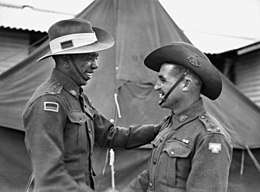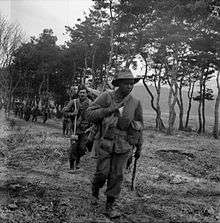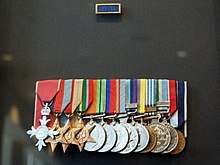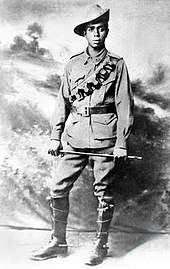Reg Saunders
Reginald Walter "Reg" Saunders, MBE (7 August 1920 – 2 March 1990) was the first Aboriginal Australian to be commissioned as an officer in the Australian Army. He came from a military family, his forebears having served in the Boer War and the First World War. Enlisting as a soldier in 1940, he saw action during the Second World War in North Africa, Greece and Crete, before being commissioned as a lieutenant and serving as a platoon commander in New Guinea during 1944–1945. His younger brother Harry also joined the Army, and was killed in 1942 during the Kokoda Track campaign.
Reg Saunders | |
|---|---|
.jpg) Reg Saunders in 1940 | |
| Birth name | Reginald Walter Saunders |
| Born | 7 August 1920 Framlingham, Victoria |
| Died | 2 March 1990 (aged 69) Sydney, New South Wales |
| Allegiance | Australia |
| Service/ | Australian Army |
| Years of service | 1940–45 1950–54 |
| Rank | Captain |
| Unit | 2/7th Battalion (1940–45) 3 RAR (1950–51) |
| Battles/wars | Second World War
Korean War
|
| Awards | Member of the Order of the British Empire |
| Other work | Department of Aboriginal Affairs |
After the war, Saunders was demobilised and returned to civilian life. He later served as a company commander with the 3rd Battalion, Royal Australian Regiment (3 RAR) during the Korean War, where he fought at the Battle of Kapyong. Saunders left the Army in 1954 and worked in the logging and metal industries, before joining the Office of Aboriginal Affairs (later the Department of Aboriginal Affairs) as a liaison officer in 1969. In 1971, he was appointed a Member of the Order of the British Empire (MBE) for his community service. He died in 1990, aged 69.
Early life
Saunders was born near Purnim on the Aboriginal Reserve at Framlingham in western Victoria on 7 August 1920.[1] He was a member of the Gunditjmara people.[2] His father, Chris, was a veteran of the First World War, having served as a machine gunner in the Australian Imperial Force.[3][4] One of his uncles, William Reginald Rawlings, who was killed in action and after whom Saunders was named,[5] had been awarded the Military Medal for service with the 29th Battalion in France.[6][7] Another ancestor, John Brook, fought with the Victorian Rifles and the Australian Commonwealth Horse in the Boer War.[8] Saunders' mother died in 1924 from complications caused by pneumonia while giving birth to her third child, a girl who also died.[9] After this, his father moved to Lake Condah in Victoria,[10] with Reg and his younger brother, Harry, born in 1922.[11] As their father undertook various labouring jobs, the two boys were raised largely by their grandmother.[1]
Saunders attended the local mission school at Lake Condah, where he did well in maths, geometry and languages. His father, meanwhile, taught Reg and Harry about the bush, and encouraged them to read Shakespeare and Australian literature. After completing eight years of schooling, Saunders earned his merit certificate.[12] His formal education thus ended, he went to work at the age of 14 as a millhand in a sawmill.[9][13] Employers regularly withheld payments for Aboriginal labourers at this time, but Saunders refused to work unless he was paid his full entitlement, and his employer relented.[13] He worked and furthered his education until 1937, when he went into business with his father and brother, operating a sawmill in Portland, Victoria; the sawmill was destroyed in a bushfire in 1939.[11][13]
Second World War
.jpg)
Following the outbreak of the Second World War, Saunders was determined to serve in the armed forces. Patriotism and his family's history of soldiering both played a major part in his decision. His father suggested that he wait six months; according to Reg, "They were talking about this war being all over in six months with the Maginot Line and all the other garbage that we were told ... But we waited six months and the duck season was over so there was no more shooting to do except go to war".[14] Saunders enlisted in the Second Australian Imperial Force on 24 April 1940,[1][15] joining up with friends he had made while playing Australian rules football.[11] The armed forces later adopted a policy to accept only persons "substantially of European origin or descent", but at the time Saunders encountered no barriers to his enlistment.[16] He recalled that his fellow soldiers "were not colour-conscious", and that during training in northern Queensland his white mates would sit alongside him in the "Aboriginal" section of movie theatres.[17] His natural leadership qualities gained him temporary promotions in quick succession: within six weeks of enlistment he was a lance corporal, and after three months he made sergeant.[9][18]
After completing his training, Saunders was allocated to an infantry unit, the 2/7th Battalion, which was serving overseas in North Africa at the time.[19] Upon reaching the 2/7th, Saunders reverted to the rank of private.[18][20] His first experience of war came fighting the Italians around Benghazi.[6][20] In early April 1941, the 6th Division, to which the 2/7th belonged, was sent to Greece to help defend against a German invasion.[19] Following a series of withdrawals, the battalion was evacuated on 26 April, embarking upon the Costa Rica at Kalamata.[20] It was originally bound for Alexandria,[21] but after the ship was attacked in Suda Bay by German aircraft and began to sink, the men of the 2/7th, including Saunders,[20] were picked up by several British destroyers and disembarked on the island of Crete. The 2/7th was subsequently allocated to the island's defending garrison.[19]
Following the invasion of Crete in May 1941, the 2/7th Battalion was initially employed in a coastal defence role, before taking part in the fighting around Canea. After this, it took part in a devastating bayonet charge at 42nd Street, along with the New Zealand Maori Battalion, which killed almost 300 Germans and briefly checked their advance.[19][22] It was during this battle that Saunders killed his first opponent:[23] "... I saw a German soldier stand up in clear view about thirty yards [30 m] away. He was my first sure kill ... I can remember for a moment that it was just like shooting a kangaroo ... just as remote."[24] As the Allies began to evacuate the island, the 2/7th was called upon to carry out a series of rearguard actions in order to allow other units to be taken off the island. After the final Allied ships departed the island on 1 June 1941, the battalion was left behind.[19] As a result, many of its men were taken prisoner, though some were able to evade capture by hiding out in the hills and caves around the island. Adopting Cretan dress, learning the dialect, and enlisting the help of local inhabitants, Saunders managed to remain hidden for eleven months.[25][26]

Saunders was among a party of men evacuated from Crete by a British submarine in May 1942, and returned to Australia in October.[2][26] He rejoined his old unit, the 2/7th Battalion, which had re-formed in Palestine and been brought back to Australia along with the rest of the 6th Division to help defend against the threat posed by Japan's entry into the war.[19] In November 1942, Saunders' younger brother Harry, who had enlisted shortly after him in 1940, was killed in action while serving in New Guinea with the 2/14th Battalion.[1][6][28] When Harry had joined up, Reg recalled, "I was angry because I was the only one that was supposed to go. ... with two of us there, one of us was going to get killed ..."[29] The elder Saunders subsequently served in New Guinea as well, fighting in the Salamaua–Lae campaign in mid-1943 where, having again been promoted temporary sergeant, he took over command of a platoon when its commander was wounded in action. For his leadership, he was recommended for a commission by his commanding officer, Lieutenant Colonel Henry Guinn.[9][30] When Guinn told him of his plan, Saunders laughed and said, "I don't want to be an officer ... I'd rather be Regimental Sergeant Major". Guinn responded, "Christ, they don't make boys RSMs".[31]
Saunders went before an officer selection board that had been set up on the Atherton Tablelands in Queensland, where the units of the 6th Division had been based following their return from New Guinea. The interview panel on the board consisted of three senior officers – all experienced infantry battalion commanders – who were tasked with determining a candidate's suitability for commissioning as an infantry officer.[32] Saunders was found to be an acceptable candidate and posted to an officer training unit in Seymour, Victoria.[6] Upon completion of the 16-week course, he was promoted to lieutenant in November 1944, becoming the first Aboriginal commissioned officer in the Australian Army.[1][33] The precedent of his commissioning had caused the Army some concern due to its "special significance", and as a result the paperwork for its confirmation was eventually sent to the Commander-in-Chief, General Sir Thomas Blamey, for approval.[34] Nevertheless, Blamey is reported to have "insisted upon following the usual procedure", believing that there should be no difference in the way Saunders' commission should be treated to any other soldier who had completed the necessary training.[9] The story garnered much press coverage in Australia, most of it favourable, if in parts paternalistic.[35]
After his promotion was confirmed, Saunders returned to New Guinea and, although it was contrary to policy, rejoined his old battalion. He subsequently took part in the Aitape–Wewak campaign, commanding a platoon until the end of the war.[36] Due to the discriminatory laws in force at the time, Saunders had fewer rights as a citizen than the white Australians he led.[37] He was wounded in the knee by Japanese gunfire during fighting around Maprik, and was hospitalised for three weeks as a result.[38][39]
Interbellum and Korean War

Saunders was discharged from the Army on 5 October 1945, following the end of the Second World War.[15] Returning to Australia, he volunteered for service in Japan with the British Commonwealth Occupation Force, but the government would not accept Aborigines for the operation.[34] Saunders spoke publicly against this policy, calling it "narrow-minded and ignorant";[40] the wartime restriction on non-European enlistments in the armed forces was not lifted until 1949.[41] Saunders moved to Melbourne with his family, which by this time consisted of his wife Dorothy, whom he had married in 1944, and their three young children.[42] Dorothy had served in the Women's Auxiliary Australian Air Force during the war.[41][43] Saunders recalled that he "had a hard time after the war ... and poor old Dotty, she, you know, didn't know what the hell to make of it".[44] Facing discrimination that he had rarely encountered as a soldier, he worked in the ensuing years as a tram conductor, a foundry worker, and a shipping clerk.[42][45]
In August 1950, the government called for Second World War veterans to serve in the Korea War as part of the specially raised 'K' Force. Saunders volunteered and returned to the Army as a lieutenant.[1][46] After training at Puckapunyal, Victoria, and in Japan,[42] he arrived in Korea in November 1950. He served with the 3rd Battalion, Royal Australian Regiment (3 RAR), initially as a platoon commander in A Company. In February 1951, he took charge of A Company when its commander was wounded; he was subsequently given command of C Company.[46] Promoted to captain, Saunders led C Company during the Battle of Kapyong in April, when 3 RAR and a Canadian battalion held off a Chinese division north-east of the South Korean capital Seoul.[47][48] Frustrated by the conduct of the war prior to Kapyong, he afterwards recorded that, "At last I felt like an Anzac and I imagine there were 600 others like me".[49] The 3rd Battalion was awarded a US Presidential Unit Citation for its part in the action. Saunders himself was recommended for a decoration but turned it down.[6][50] Leading a Vickers machine gun platoon at the Battle of Maryang San in October, he reportedly shared the following exchange with a fellow 3 RAR officer: as they surveyed the forbidding mountain before them, Saunders' companion remarked, "No country for white men", to which Saunders replied, "It's no country for black men, either".[51] He returned to Australia in November 1951.[52]
Later life
In 1953 the Returned and Services League (RSL), a veterans organisation, recommended Saunders for inclusion in the official Australian contingent to the coronation of Elizabeth II; the Federal government rejected the suggestion on the grounds that including Saunders would have meant excluding an officer who had been previously selected.[53][54] Following his service in the Korean War, Saunders remained in the Army overseeing training for national servicemen at Puckapunyal. Away from active service, however, he soon became dissatisfied and in 1954 was discharged at his own request.[1][34] The same year, he married an Irish nurse, Pat Montgomery; his first marriage had broken down soon after he returned from Korea.[55]
Saunders went to work in the logging industry in Gippsland, after which he moved to Sydney, where he was employed by the Austral Bronze Company.[1] Seen by many as a role model and spokesman for Aboriginal Australians, in 1969 Saunders took up a position in the Office of Aboriginal Affairs as one of its first liaison officers.[36][37] Among his tasks was promulgating information on recently legislated Federal funding for Aboriginal and Torres Strait Islander businesses and schooling, following up on recommendations made to government departments, and liaising with Aboriginal welfare groups.[56] He later stated, "I felt a sense of leadership of Aboriginal people and a desire to do something about the Aboriginal situation".[57] His community work was recognised in the Queen's Birthday Honours of June 1971 when he was appointed a Member of the Order of the British Empire (MBE) in the Civil Division.[58][59] He continued to serve with the Department of Aboriginal Affairs in Canberra until retiring in 1980.[60] In July 1985 he was appointed to the Council of the Australian War Memorial, and held this position until his retirement.[37][61] He was also involved in the RSL, though he fell out with leaders Alf Garland and Bruce Ruxton over Garland's suggestion that Aborigines be blood-tested to determine their entitlement to government benefits. "They can take all the blood they want from me," Saunders declared in a 1986 interview, "and they'll never find out what I am – least of all an Aborigine – bloody stupid!"[62]
During his two marriages, both of which ended in divorce, Saunders fathered ten children, two of whom predeceased him.[1] Having suffered recent heart trouble,[63][64] he died on 2 March 1990.[1] His ashes were scattered on Lake Condah, traditional territory of the Gunditjmara people.[64][65] Of Saunders' children, one of his sons followed him into the Army, while four of his daughters married soldiers.[5] His son Christopher portrayed him in a 1978 episode of the television series The Sullivans.[66]
Memorials

On 14 December 2001, Saunders was honoured with the dedication of Reg Saunders Way, which passes through the Canberra suburbs of Campbell and Russell, in a ceremony attended by the Secretary of the Department of Defence, Dr Allan Hawke, and the Chief of the Defence Force, Admiral Chris Barrie.[67][68] Saunders was also commemorated with a room in the Canberra Services Club, and by the RSL's Captain Reg Saunders Scholarship.[10][69] The Australian War Memorial holds Saunders' medals and several personal effects in its national collection, along with an official portrait and several photographs.[37] On 11 November 2015 the Australian War Memorial's Western Gallery and Courtyard were renamed in Saunders' honour. These were the first sections of the Memorial to be named after any Australian.[70]
Notes
- "Captain Reginald Walter (Reg) Saunders, MBE". Australian War Memorial. Retrieved 21 July 2009.
- O'Connell 2011, p. 26.
- Ramsland; Mooney 2006, pp. 181–182.
- "Walter Christopher George Saunders". The AIF Project. Australian Defence Force Academy. Retrieved 12 May 2012.
- Lennox 2005, p. 157.
- "Case Study: Reginald Saunders" (PDF). Memorial Box 3: Too Dark for the Light Horse. Australian War Memorial. Retrieved 13 April 2012.
- "No. 31061". The London Gazette (Supplement). 11 December 1918. p. 14663.
- Forbes 2010, pp. 271–272.
- Hall 1997, p. 65.
- "Captain Reginald Saunders". Australian Broadcasting Corporation. 23 June 2009. Retrieved 21 July 2009.
- Lennox 2005, p. 158.
- Ramsland; Mooney 2006, pp. 180–181.
- Ramsland; Mooney 2006, p. 181.
- Hall 1995, pp. 63–64.
- "WW2 Nominal Roll: Saunders, Reginald Walter". Department of Veterans' Affairs. Retrieved 20 April 2015.
- Hall 1995, pp. 67–68.
- Hall 1997, p. 70.
- Ramsland; Mooney 2006, pp. 182–183.
- "2/7th Australian Infantry Battalion". Australian War Memorial. Retrieved 20 April 2015.
- Lennox 2005, p. 159.
- Long 1953, p. 174.
- "Battle of 42nd Street". Australian War Memorial. Retrieved 13 April 2012.
- Thompson 2010, p. 355.
- Forbes 2010, p. 291.
- Hall 1995, p. 74.
- Ramsland; Mooney 2006, pp. 183–184.
- Stanley 1997, p. 147.
- "Casualty Details: Saunders, Harry". Commonwealth War Graves Commission. Retrieved 30 July 2012.
- Hall 1995, p. 65.
- Ramsland; Mooney 2006, pp. 184–186.
- Hall 1995, p. 79.
- Forbes 2010, p. 286.
- Dexter 1961, p. 24.
- Dennis et al. 2008, p. 478.
- Ramsland; Mooney 2006, pp. 188–189.
- "Reginald Walter Saunders, MBE (1920–1990)". Fifty Australians. Australian War Memorial. Retrieved 18 May 2012.
- O'Connell 2011, p. 28.
- Hall 1995, p. 80.
- Ramsland; Mooney 2006, p. 191.
- Ramsland; Mooney 2006, p. 193.
- Hall 1995, p. 85.
- Lennox 2005, p. 162.
- "WW2 Nominal Roll: Saunders, Dorothy Mary". Department of Veterans' Affairs. Retrieved 20 April 2015.
- Hall 1995, p. 86.
- Ramsland; Mooney 2006, pp. 191–192.
- O'Neill 1985, p. 64.
- O'Neill 1985, pp. 154–157.
- Dennis et al. 2008, pp. 302–303.
- Forbes 2010, pp. 269, 382.
- Ramsland; Mooney 2006, pp. 194–195.
- Forbes 2010, p. 406.
- "Nominal Roll of Australian Korea War Veterans: Saunders, Reginald Walter". Australian Government. Retrieved 20 April 2015.
- "Reg Saunders – our only "dinkum Aussie" officer". Portland Guardian. Portland, Victoria: National Library of Australia. 9 March 1953. p. 3. Retrieved 26 September 2013.
- "Saunders to stay home". The Barrier Miner. Broken Hill: National Library of Australia. 10 March 1953. p. 3. Retrieved 26 September 2013.
- Ramsland; Mooney 2006, pp. 196–199.
- Rowse 2000, pp. 40, 72.
- Hall 1995, p. 87.
- "No. 45385". The London Gazette (Supplement). 4 June 1971. p. 5994.
- "Australian Honours Database Search: Saunders, Reginald Walter". Australian Government. Retrieved 21 July 2009.
- O'Neill 1985, p. 671.
- "Captain Reginald Walter (Reg) Saunders, MBE – Timeline". Australian War Memorial. Retrieved 20 March 2012.
- Hall 1995, pp. 88–89.
- Flanagan, Martin (25 April 1989). "We can make peace, says an old warrior". The Age. p. 9. Retrieved 28 May 2012.
- Lennox 2005, p. 166.
- "Case Study 4: Lake Condah, Budj Bim National Heritage Landscape" (PDF). Victorian Government. p. 50. Archived from the original (PDF) on 27 April 2015. Retrieved 20 April 2015.
- Lahey, John (8 June 1978). "Flashback to forgotten hero". The Age. p. 2. Retrieved 28 May 2012.
- "World War 2 Heroes to Be Honoured at Russell". Department of Defence. Retrieved 20 March 2012.
- "Reg Saunders Way". Place name search. ACT Planning and Land Authority. Archived from the original on 4 March 2016. Retrieved 20 April 2015.
- "Captain Saunders honoured by club". Stand To. Returned and Services League of Australia. August–September 2009. p. 10. Retrieved 20 April 2015.
- Kelly, Emma (11 November 2015). "Australian War Memorial gallery named in honour of Indigenous soldier Reg Saunders". The Canberra Times. Retrieved 28 January 2017.
References
- Dennis, Peter; Grey, Jeffrey; Morris, Ewan; Prior, Robin (2008) [1995]. The Oxford Companion to Australian Military History. South Melbourne: Oxford University Press. ISBN 978-0-19-551784-2.
- Dexter, David (1961). The New Guinea Offensives. Australia in the War of 1939–1945. Series 1 (Army) Volume VI. Canberra: Australian War Memorial. OCLC 2028994.
- Forbes, Cameron (2010). The Korean War: Australia in the Giants' Playground. Sydney: Pan Macmillan Australia. ISBN 978-1-4050-4001-3.
- Hall, Robert (1997) [1989]. The Black Diggers. Canberra: Aboriginal Studies Press. ISBN 0-85575-319-6.
- Hall, Robert (1995). Fighters From the Fringe: Aborigines and Torres Strait Islanders Recall the Second World War. Canberra: Aboriginal Studies Press. ISBN 0-85575-286-6.
- Lennox, Gina (2005). Forged by War: Australians in Combat and Back Home. Carlton, Victoria: Melbourne University Press. ISBN 978-0-522-85171-7.
- Long, Gavin (1953). Greece, Crete and Syria. Australia in the War of 1939–1945. Series 1 (Army) Volume II. Canberra: Australian War Memorial. OCLC 3134080.
- O'Connell, Garth (October 2011). "Leading From the Front". Wartime. No. 56. pp. 26–28. ISSN 1328-2727.
- O'Neill, Robert (1985). Combat Operations. Australia in the Korean War 1950–53. Volume II. Canberra: Australian War Memorial & Australian Government Publishing Service. ISBN 0-642-04330-2.
- Ramsland, John; Mooney, Christopher (2006). Remembering Aboriginal Heroes: Struggle, Identity and the Media. Melbourne: Brolga Publishing. ISBN 1-920785-85-X.
- Rowse, Tim (2000). Obliged to Be Difficult: Nugget Coombs' Legacy in Indigenous Affairs. Cambridge: Cambridge University Press. ISBN 0-521-77353-9.
- Stanley, Peter (1997). Tarakan: An Australian Tragedy. St Leonards, New South Wales: Allen & Unwin. ISBN 978-1-86448-278-2.
- Thompson, Peter (2010). Anzac Fury: The Bloody Battle of Crete 1941. North Sydney: William Heinemann. ISBN 978-1-86471-131-8.
Further reading
| Wikimedia Commons has media related to Reg Saunders. |
- Cadzow, Allison; Jebb, Mary Anne (2019). Our Mob Served: Aboriginal and Torres Strait Islander Histories of War and Defending Australia. Canberra, Australian Capital Territory: Aboriginal Studies Press. ISBN 9780855750718.
- Dolan, Hugh; Threlfall, Adrian (2015). Reg Saunders: An Indigenous War Hero. Sydney: NewSouth. ISBN 9781742234243.
- McIntyre, Darryl (2012). "Saunders, Reginald Walter (Reg) (1920–1990)". Saunders, Reginald Walter (1920–1990). Australian Dictionary of Biography. National Centre of Biography, Australian National University.
